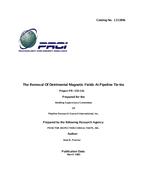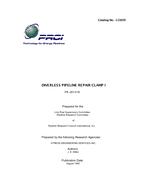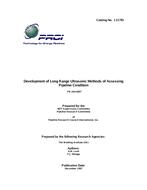Provide PDF Format
PRCI PR-12-66
- The Effects of Storing Odorized Gas in Gas Storage Reservoir
- Report / Survey by Pipeline Research Council International, 04/01/1974
- Publisher: PRCI
$48.00$95.00
L41007e
The Pennsylvania State University
Need: Natural gas is the cleanest burning and one of the cheapest of all the primary fossil fuels. It is almost completely combustible, giving off waste products consisting mainly of water and carbon dioxide and very small amounts of sulfur and nitrogen oxides. The high efficiency of combustion and the low level of environmental pollutants given off in the process have generated a great demand for more natural gas by both industry and the average consumer. Since natural gas is generally processed in desulphurization plants to remove corrosive sulfides prior to transmission, the gas is essentially odorless and colorless when it leaves the plant. Odorizing the gas allows quick detection of leaks, thus reducing the possibility of accident or the wasting of large quantities of gas.
Result: In an extensive series of experiments conducted at Penn State, odorized methane was flowed through sandstone and dolomite cores in the dry, water wet, and oil saturated states to determine the effects that odorants may have on storage reservoir rocks. The purpose of this research was to determine the effects of storing odorized natural gas in gas storage reservoir rocks. The investigation was tailored primarily to observe odorant adsorption and permeability changes in cores resulting from the flow of odorized methane through them. Three different odorant types were used to odorize chemically pure (C.P.) grade methane near and above the odor levels recommended by the manufacturer. Sandstone and dolomite cores were tested in the dry, water wet, and oil saturated states.
Benefit: It was concluded from the study that odorants are adsorbed to some degree in all reservoir rocks no matter what type of rock or what state the rock may be in, i.e. dry, water wet, or oil saturated. A greater amount of adsorption takes place in the more permeable sandstones than the less permeable dolomites, Dry rocks adsorb more odorant, than water wet rocks; water wet rocks adsorb slightly more than oil saturated rocks. It was found that there is a greater percent change in odorant concentration in tests using low initial odorant levels in the methane; the higher the initial odorant concentration in the gas, the smaller the percent change in concentration. The process of odorant adsorption in reservoir rocks is a reversible process whereby gases of low odorant concentration will absorb odorant that had been previously adsorbed by the rock. It is statistically shown that there is no significant reduction in permeability resulting from the flow of odorized gas through rock. The "drying effect" of gas on connate water saturation in the rock far outweighs any adsorption effects caused by the odorized gas.
The Pennsylvania State University
Need: Natural gas is the cleanest burning and one of the cheapest of all the primary fossil fuels. It is almost completely combustible, giving off waste products consisting mainly of water and carbon dioxide and very small amounts of sulfur and nitrogen oxides. The high efficiency of combustion and the low level of environmental pollutants given off in the process have generated a great demand for more natural gas by both industry and the average consumer. Since natural gas is generally processed in desulphurization plants to remove corrosive sulfides prior to transmission, the gas is essentially odorless and colorless when it leaves the plant. Odorizing the gas allows quick detection of leaks, thus reducing the possibility of accident or the wasting of large quantities of gas.
Result: In an extensive series of experiments conducted at Penn State, odorized methane was flowed through sandstone and dolomite cores in the dry, water wet, and oil saturated states to determine the effects that odorants may have on storage reservoir rocks. The purpose of this research was to determine the effects of storing odorized natural gas in gas storage reservoir rocks. The investigation was tailored primarily to observe odorant adsorption and permeability changes in cores resulting from the flow of odorized methane through them. Three different odorant types were used to odorize chemically pure (C.P.) grade methane near and above the odor levels recommended by the manufacturer. Sandstone and dolomite cores were tested in the dry, water wet, and oil saturated states.
Benefit: It was concluded from the study that odorants are adsorbed to some degree in all reservoir rocks no matter what type of rock or what state the rock may be in, i.e. dry, water wet, or oil saturated. A greater amount of adsorption takes place in the more permeable sandstones than the less permeable dolomites, Dry rocks adsorb more odorant, than water wet rocks; water wet rocks adsorb slightly more than oil saturated rocks. It was found that there is a greater percent change in odorant concentration in tests using low initial odorant levels in the methane; the higher the initial odorant concentration in the gas, the smaller the percent change in concentration. The process of odorant adsorption in reservoir rocks is a reversible process whereby gases of low odorant concentration will absorb odorant that had been previously adsorbed by the rock. It is statistically shown that there is no significant reduction in permeability resulting from the flow of odorized gas through rock. The "drying effect" of gas on connate water saturation in the rock far outweighs any adsorption effects caused by the odorized gas.
Related Products
PRCI PR-164-9207
Development of Long Range Ultrasonic Methods of Assessing Pipeline Condition (Phase 4)..
$198.00 $395.00
PRCI NG - 18 Report 167
Surface Effects on Stress Corrosion Susceptibility of Line Pipe Steels..
$48.00 $95.00





